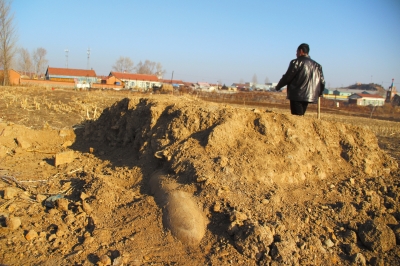Japan urged to destroy chemical weapons

Chinese scholars have urged Japan to provide detailed information about chemical weapons abandoned in China to prevent further harm to innocent Chinese people. Their call came on April 29, recognized internationally as the Day of Remembrance for All Victims of Chemical Warfare.
April 21 marked the 100th anniversary of the first use of chemical weapons in World War I at Ypres, Belgium. In commemoration of the milestone, UN Secretary-General Ban Ki-moon called on the international community not to forget historical lessons and to “rid the world of chemical weapons once and for all” to ensure that mankind is free from grave threats posed by the use of chemical weapons.
In World War II (WWII), Japan was the main aggressor of chemical warfare. China suffered heavy losses from Japan’s chemical warfare during this period. The Imperial Japanese Army (IJA) used chemical weapons more than 2,000 times in 19 Chinese cities and provinces during WWII, injuring or killing more than 100,000 Chinese soldiers and civilians.
Chemical weapons abandoned by the IJA in WWII continue to harm people in Northeast China. Cao Zhibo, a scholar from Qiqihar, Heilongjiang Province, likened gas bombs secretly dumped by the Japanese military forces to “hidden demons.”
In August 2003, a fatal toxic gas leakage from abandoned Japanese chemical weapons killed one person and injured 42 others after barrels of mustard gas were dug up at a construction site in Qiqihar.
Lu Yi, a professor from the University of International Relations, said similar tragedies have taken place in Lianhuapao, a forestry farm in Dunhua, Jilin Province; Ji’an, Heilongjiang Province; Panyu District of Guangzhou, Guangdong Province; Taiyuan, Shanxi Province; and the Tianjin Economic-Technological Development Area.
On Nov. 30, 2014, China and Japan jointly announced the start of an initiative to destroy chemical weapons abandoned by Japan in the Harbaling area of Dunhua. The move was a decisive step toward accelerating the destruction of all chemical weapons.
Harbaling is regarded as the largest dumping site of chemical arms abandoned by Japan. Investigations conducted by China and Japan indicate that there are approximately 330,000 weapons buried in the area.
Having investigated chemical weapons in Dunhua, Guo Maohong, director of the Institute of Japanese Studies at the Jilin Academy of Social Sciences, said about 85 percent of Japan’s abandoned chemical weapons are in Northeast China, with the majority in Dunhua.
Japan’s chemical warfare was conducted in secrecy due to international conventions that prohibited such operations, said Gao Xiaoyan, a research fellow at the Heilongjiang Academy of Social Sciences. Following Japan’s defeat in WWII, IJA troops abandoned their chemical weapons in similar secrecy to cover up their crimes. Some chemical weapons were discovered in areas of civilian residence and others were mixed with regular weapons handed over to the Allies. However, many weapons were secretly buried or dumped into rivers.
Many gas bombs were buried underground at Unit 516, a secret Japanese chemical weapons facility in Qiqihar, or dumped in the Nen River, which flows through North Heilongjiang.
As stipulated by the Convention on the Banning of Chemical Weapons, any country that produced chemical weapons should effectively undertake obligations to destroy such weapons abandoned in other countries.
However, the destruction of chemical weapons in China has been seriously hindered due to a lack of cooperation on the Japanese side. The deadline for the destruction of chemical weapons in China has subsequently been extended to April 2022.
Lu noted that Japan “holds a negative attitude towards the destruction [of chemical weapons] and delays the deadline again and again,” adding that Japan is “shirking its responsibility and easing its burden.”
There are links between chemical and biological warfare carried out by Japan in China despite key differences. Unit 731, a covert biological and chemical warfare research and development unit of the IJA based in Harbin, Heilongjiang Province, was notorious for its germ warfare program. However, war crimes committed at other units engaged in chemical operations remain relatively unknown, highlighting the need for further research.
Xie Xueshi, a research fellow at the Jilin Academy of Social Sciences, said that the chemical and biological warfare troops belonged to two systems.
Chemical warfare is also called “gas warfare.” The IJA used chemical weapons more widely and with greater impact, Xie said.
Germ warfare was waged later. Germ warfare units were mainly based in Harbin and Changchun, Jilin Province, while chemical warfare units, such as the Unit 516, were based in Qiqihar, he said.
There is an urgent need to address the realistic problem of chemical weapons abandoned by Japan. In Northeast China, large quantities of abandoned chemical weapons need to be destroyed, but the destruction progress has been quite slow. Scholars have urged academia to strengthen research on these issues to accelerate the destruction of weapons.
Zeng Jiang is a reporter at the Chinese Social Sciences Today.

 PRINT
PRINT CLOSE
CLOSE